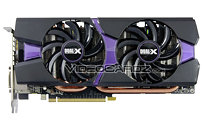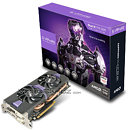Sunday, August 10th 2014

Sapphire Radeon R9 285 "Tonga" Pictured
Here are the first pictures of the card AMD hopes to take on NVIDIA's bestselling GeForce GTX 760 with, the Radeon R9 285. This particular one, branded by Sapphire, featuring its Dual-X cooling solution. The R9 285 is based on a brand new chip by AMD, codenamed "Tonga." It's rumored to feature the same stream processor count as one of the "Tahiti" variants, while featuring higher clocks, and a narrower 256-bit wide GDDR5 memory interface, a fact confirmed by this card's marketed 2 GB of memory. Given how marketing material of the R9 285 is ready, its launch may not be far away.
Source:
VideoCardz


13 Comments on Sapphire Radeon R9 285 "Tonga" Pictured
How do you know it's positioned against the GTX 760? If I were to guess, the new 285 series might be direct replacements for the R9 290 and 290x. How do I know? Well, I'm just guessing, just like the OP...
Should be more along the 770/780 performance...
I guess it depends how much 256bit limits it and how much gcn2 tweaks help it...
5500mhz (with corresponding stream processor/clock to match it) puts it squarely against the 760. That's just math:
5500mhz is around enough for 1536sp at 1018mhz or 873mhz with 1792. I think the likely scenario is the former, but it could be the later, certainly (and hopefully). The later would be more efficient, but clockspeed of 918mhz (base clock?) makes me think the former...but sometimes amd clocks their chips a little higher to make up optimal texture rate etc differences, so it's possible it's 1792 even if 918mhz boost clock. We'll know soon enough.
Just taking that (baseline, assuming similar to past GCN products) and comparing it to 760:
1018*1536/1344 = 1164mhz, if both have close to perfect bandwidth/flop.
(*760 is 6*192sp+32sfu = similar to 1344sp when not limited by compute)
At that clock 760 would need around 4715mhz ram clock, but it has a base of 6000.
6000/4715 = 1.2725
.2725*.16 = 1.0436 (approx added performance for extra bw)
1164/1.0436 = 760 @ 1116/6000 ~= 285 @ aprox optimal flops/5500mhz @ 256-bit.
A 760 generally boosts to around that level during normal operation.
So, essentially (granted things vary based on where a bottleneck is in a scenario) they should be similar, especially if amd clocks their core slightly above optimal to even out some advantages nvidia has per flop/clock, and obviously in compute heavy scenarios will be superior.
Doesn't matter if it's 1792 or 1536sp though, really. What matters (I suppose) is max bandwidth and the maximum power allowed by powertune; where amd wants it to perform overall vs other products. I can't imagine it going much higher than something like 1185/6400 (given where 6ghz ram often craps out) if 1536sp or relatively lower if 1792sp...either way that's (overall) very similar to how an overclocked 760 would perform (at something like 1300/6400). It could be slightly faster if the ram scales higher, and amd allows high-enough voltage tweaking/power consumption (the former being more important if less shaders) etc, but I wouldn't get my hopes up far past a fairly similar part unless there is some dramatic architecture revelation we don't know yet.
That just doesn't compute? A bigger model number than 280 but with less RAM.
I hope we will not have a repeat of the 7700 series replacement fiasco with those pathetic worst performing R7 240, R7 250 cards. I hope that 285, offers indeed better performance than 280 to justify that extra 5 even having less memory.
not only the Sapphire one
It will probably be like R9 280X > R9 285 > R9 280 though, since Tonga is newer (and possibly faster) than the HD 7950.
and what about the price. it should be in the middle of those 2 cards too right ??
285 should be faster than 280 and 280X, but how much faster? Faster everywhere or just on most cases? We'll have to wait and see.